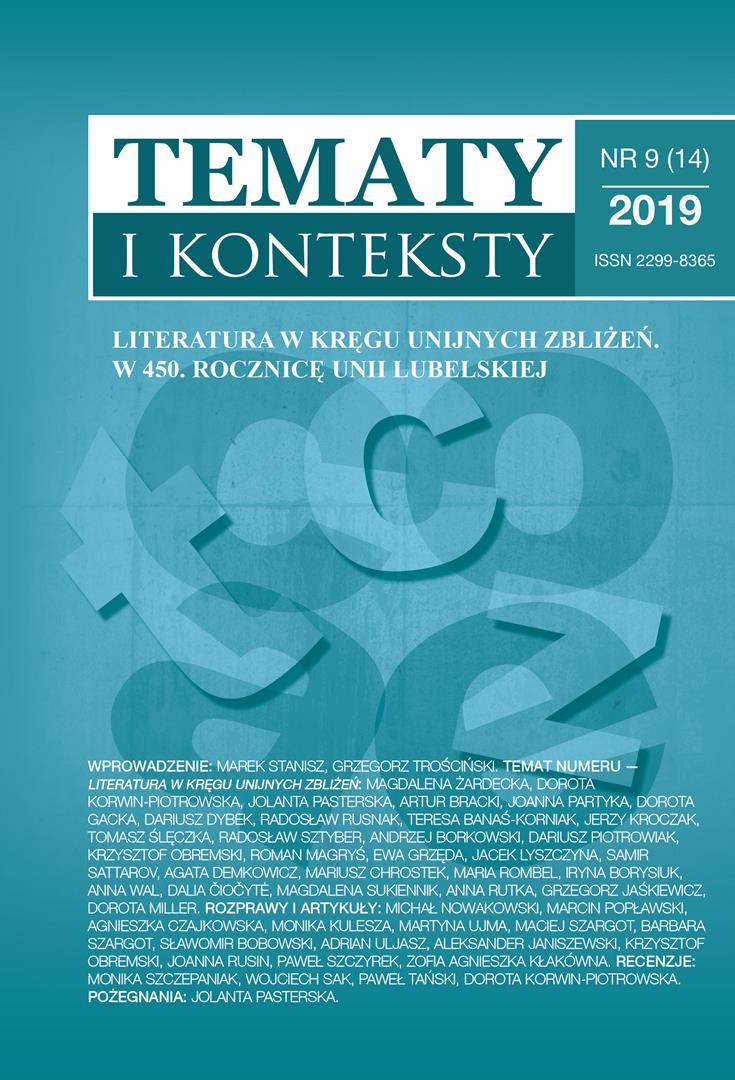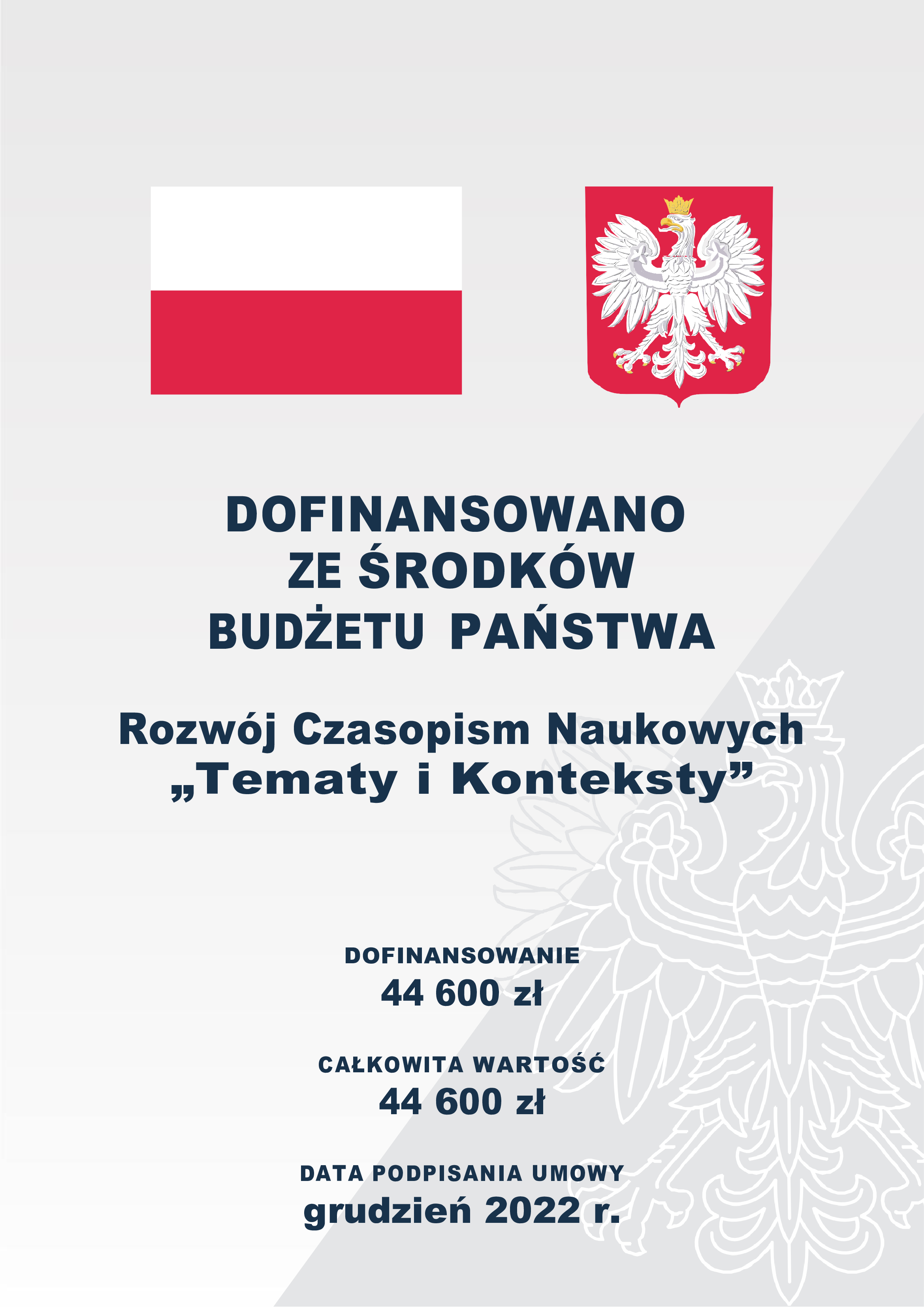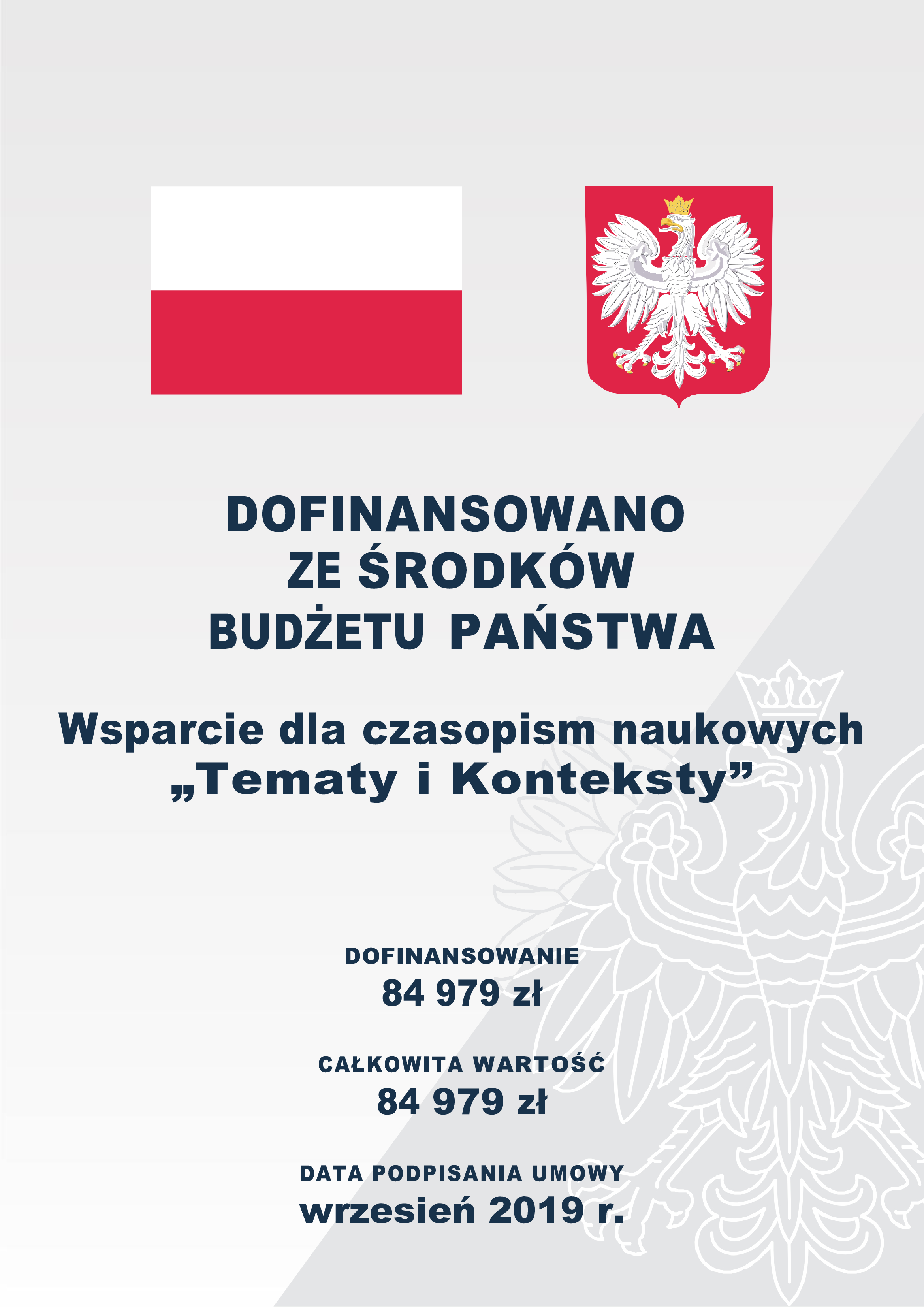Polacy, Żydzi i antysemityzm w publicystyce Ryszarda Ganszyńca
DOI:
https://doi.org/10.15584/tik.2019.22Słowa kluczowe:
Ryszard Ganszyniec, Uniwersytet Jana Kazimierza, Lwów, antysemityzm, Żydzi, studenci, Młodzież Wszechpolska, numerus clausus, getto ławkowe, dyskryminacjaAbstrakt
Ryszard Ganszyniec, an outstanding classicist, professor at the Jan Kazimierz University in the years 1920-1939 and, on and off, until 1946, as one of a few academic lecturers, openly opposed the growing wave of antisemitism among Polish students in interwar Lviv. His readings inspired by events at universities - the introduction of the so-called numerus clausus principle and of the bench ghetto in the thirties - were published in the form of two extensive brochures: The case of “numerus clausus” and its fundamental meaning. Academic antisemitism as a symptom of social antisemitism (1925) and Bench Ghetto (1937). The author did not only expose the low motives and methods of Polish nationalists. As a discerning humanist, he spoke on the principles of coexistence of two nations, Poles and Jews, in the new conditions of the resurgent Polish State after 123 years of political dependence. Despite the increasing acts of violence against Jewish youth, inspired mainly by the All-Polish Youth (beatings and even murders in the 1930s), and the passive, quiet consent of the majority of professors, Ganszyniec dealt with the phenomenon of numerus claususus on ethical, religious, economic and sociological levels. He reminded zealous Catholic nationalists of the Jewish origin of Christ. He juxtaposed the industriousness and austerity of Jews with the ineptitude of Poles, particularly visible in trade. He warned that attempts to transform the Polish nation into a politically and ethnically uniform formation would never succeed. He proved that privileging Polish students at universities leads them to laziness and strengthens their demanding attitudes. The bench ghetto, introduced by force during lectures, would begin to isolate Jewish shops, services, houses, and create places of retreat for this nation similar to the German concentration camps already existing at that time. Ganszyniec predicted that the Jews would be followed by communists, socialists, peasant activists and the entire opposition, until finally the single party system would take over, for which the Constitution would be only a “piece of paper”. The scholar saw the bench ghetto as a dangerous element in the nazification of society. One of the greatest weaknesses of Polish chauvinists, as he saw it, was the lack of any arguments for the alleged superiority of the “Polish race”. He easily proved the superiority of Jewish merits over those of Poles in building world cultural heritage. The postulates of the Lviv classicist, which made him many enemies, could not influence the situation at Polish universities on the eve of the Second World War, when two totalitarian systems were tightening around the Republic of Poland: Nazi and Stalinist.
Downloads
Bibliografia
Źródła archiwalne z Państwowego Archiwum Obwodowego we Lwowie (Dierżawnyj Archiw Lwiwskoji Obłasti – DALO) według numeracji w porządku rosnącym
DALO f. 26, op. 7, spr. 819, k. 6 (decyzja Rady Wydziału Filozoficznego o wprowadzeniu numerus clausus, dokument z 14 października 1921 r.)
DALO f. 26, op. 7, spr. 819, k. 7–8 (odpowiedź Ministerstwa WRiOP z 21 listopada 1921 r.: wstrzymuje się od zatwierdzenia uchwały rady wydziału)
DALO f. 26, op. 7, spr. 819, k. 31 (dwustronnie) (młodzież polska zrzeszona w wielu organizacjach do Rady Wydziału Filozoficznego o wprowadzenie numerus clausus w roku 1923/1924)
DALO f. 26, op. 7, spr. 868, k. 9–12 (dwustronnie) (Memoriał polskiej młodzieży Lwowa o zachowanie polskości lwowskich uczelni, wniesiony do senatów 3 uczelni, dokument z 21 września 1922 r.)
DALO f. 26, op. 7, spr. 868, k. 15–16 (Komitet Wykonawczy Wiecu Polskiej Młodzieży do senatu – ponownie za wprowadzeniem numerus clausus i przeciw Żydom studiującym w UJK, dokument z 30 października 1922 r.)
DALO f. 26, op. 7, spr. 868, k. 18–20 (rezolucja z 1 października 1922 r.)
DALO f. 26, op. 7, spr. 1398, k. 147 (rektor do młodzieży w sprawie krwawej napaści na Żydów w gmachu UJK, 27 października 1936 r.)
DALO f. 26, op. 7, spr. 1432, k. 65 (rektor do młodzieży akademickiej w sprawie napaści na Żydów)
Artykuły w „Słowie Polskim” (układ chronologiczny)
Wpisy na uniwersytet, „Słowo Polskie” 1920, nr 566, s. 6.
Tad. Bert., Sprawa żydowska na lwowskich wyższych uczelniach, „Słowo Polskie” 1921, nr 463, s. 5.
Demonstracje akademików we Lwowie, „Słowo Polskie” 1931, nr 312, s. 7.
Na Uniwersytecie i Politechnice panuje spokój, „Słowo Polskie” 1931, nr 313, s. 7.
Wiadomości akademickie, R. III, nr 27: Życie samopomocowe, „Słowo Polskie” 1932, nr 200, s. 9.
Demonstracje studenckie, „Słowo Polskie” 1932, nr 313, s. 7.
Pokłosie rozruchów studenckich, „Słowo Polskie” 1933, nr 62, s. 7.
Wyrok w sprawie 12 akademików, „Słowo Polskie” 1933, nr 63, s. 4.
Sytuacja na wyższych uczelniach Lwowa, „Słowo Polskie” 1933, nr 66, s. 7.
Spokój na odcinku akademickim, „Słowo Polskie” numer nieoznaczony z 9 marca 1933 r., s. 7.
Ekscesy studenckie we Lwowie, „Słowo Polskie” numer nieoznaczony z 11 marca 1933 r., s. 4.
Wyroki w sprawie zajść studenckich, „Słowo Polskie” numer nieoznaczony z 13 marca 1933 r., s. 4.
Chajes W., Semper fidelis. Pamiętnik Polaka wyznania mojżeszowego z lat 1926–1939, wstępem i przypisami opatrzył P. Pierzchała, przedmowa T. Krzyżewski, Kraków 1997.
Chrostek M., Złote lata polonistyki lwowskiej (1919–1939), Rzeszów 2016.
Draus J., Uniwersytet Jana Kazimierza we Lwowie 1918–1946. Portret kresowej uczelni, Kraków 2007.
Gansiniec [Ganszyniec] R., Notatki lwowskie (1944–1946), Wrocław 1995.
Ganszyniec R., Ghetto ławkowe. Odczyt wygłoszony 16 listopada 1937 roku, Lwów 1937.
Ganszyniec R., O minimum logiki, „Epoka” 1937, nr 23, s. 8.
Ganszyniec R., Sprawa „numerus clausus” i zasadnicze jej znaczenie. Antysemityzm akademicki jako objaw antysemityzmu społecznego, Warszawa 1925.
Garbaczowska J., Z przeżyć i wspomnień asystentki Juliusza Kleinera, w: Juliusz Kleiner. Księga zbiorowa o życiu i działalności, red. F. Araszkiewicz, Lublin 1961, s. 184–188.
Hen J., Nie boję się bezsennych nocy… z księgi trzeciej, Warszawa 2001.
Jahn A., Z Kleparowa w świat szeroki, Wrocław 1991.
Jakubowska U., Lwów na przełomie XIX i XX wieku. Przegląd środowisk prasotwórczych, Warszawa 1991.
Kamińska-Kwak J., Inteligencja województwa lwowskiego w okresie międzywojennym, Rzeszów 2005.
Kridl M., Przypomnienie starych i prostych prawd, „Wiadomości Literackie” 1937, nr 45.
Kronika Uniwersytetu Jana Kazimierza we Lwowie za rok szkolny 1920–1921 za rektoratu prof. dra Emanuela Macheka, Lwów 1923.
Kronika Uniwersytetu Jana Kazimierza we Lwowie za rok szkolny 1923–1924 za rektoratu prof. dra Juliusza Makarewicza, Lwów 1924.
Kronika Uniwersytetu Jana Kazimierza we Lwowie za rok szkolny 1924/25 stanowiąca sprawozdanie rektora i dziekanów, zestawił rektor prof. dr Włodzimierz Sieradzki, Lwów 1925.
Kronika Uniwersytetu Jana Kazimierza we Lwowie za rok szkolny 1929/30 stanowiąca sprawozdanie rektora i dziekanów, zestawił rektor prof. dr Hilary Schramm, Lwów 1931.
Landau-Czajka A., Syn będzie Lech… Asymilacja Żydów w Polsce międzywojennej, Warszawa 2006.
Mycielska D., Postawy polityczne profesorów wyższych uczelni w dwudziestoleciu międzywojennym, w: Inteligencja polska XIX i XX wieku, t. IV, red. R. Czepulis-Rastenis, Warszawa 1985, s. 293–335.
Pierzchała P., Wstęp [do:] W. Chajes, Semper fidelis. Pamiętnik Polaka wyznania mojżeszowego z lat 1926–1939, wstępem i przypisami opatrzył P. Pierzchała, przedmowa T. Krzyżewski, Kraków 1997, s. 5–28.
Regulamin wpisów na Uniwersytet Jana Kazimierza we Lwowie w roku akademickim 1933/34, Lwów 1933.
Sandauer A., Wspomnienia, w: Księga wspomnień 1919–1939, Warszawa 1960, s. 334–353.
Steinhaus H., Wspomnienia i zapiski, oprac. A. Zgorzelska, Wrocław 2002.
Szmyd K., Twórcy nauk o wychowaniu w środowisku akademickim Lwowa (1860–1939), Rzeszów 2003.
Turasiewicz R., Ryszard Gansiniec, w: Uniwersytet Jagielloński. Złota Księga Wydziału Filologicznego, red. J. Michalik, W. Walecki, Kraków 2000, s. 385–397.
Tyrowicz M., Wspomnienia o życiu kulturalnym i obyczajowym Lwowa 1918–1939, z przedmową J. Maślanki, Wrocław 1991.
Ułaszyn H., Z Kopiowatej na katedry uniwersyteckie. Wspomnienia, z rękopisu oprac., przypisami opatrzył i wydał M. Skarżyński, Kraków 2010.
Wołczański J., Wydział Teologiczny Uniwersytetu Jana Kazimierza we Lwowie 1918–1939, Kraków 2002.
Pobrania
Opublikowane
Jak cytować
Numer
Dział
Licencja
Prawa autorskie (c) 2019 Tematy i Konteksty

Utwór dostępny jest na licencji Creative Commons Uznanie autorstwa – Użycie niekomercyjne – Bez utworów zależnych 4.0 Międzynarodowe.




